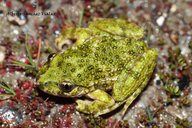|
Description
The species is very similar to its relative, the Caucasian Parsley Frog (Pelodytes caucasicus), but differs from the latter mainly in having shorter hind legs, vomerine teeth rows positioned between the anterior edges of the choanae (internal openings of naresJ), smaller snout-vent length, and details of structure of fingers and some morphometric indices. Distribution and Habitat
Country distribution from AmphibiaWeb's database: Belgium, France, Italy, Luxembourg, Portugal, Spain
The species inhabits a part of Iberian Peninsula and small territories somewhat northwards. The eastern margin of the range runs from Northern Italy (Piedmont and Liguria), through the Eastern France to parts of Belgium and Luxembourg. On the Iberian Peninsula, the frog lives mainly in the southern and the northwestern regions, being distributed discontinuously or absent from large central and northern areas.The species inhabits light forests (including pine forests), as well as open and agricultural landscapes. It occurs usually in stagnant waters, from deep ponds to small pools of water, flooded quarries, weakly flowing brooks etc. Preferred habitats are stony and sandy areas.Life History, Abundance, Activity, and Special Behaviors
The species is not abundant, especially at the northern margin of its range and in anthropogenically alternated landscapes.Hibernation occurs only in the northern parts of the species distribution and for a short time (from November to February - March). Reproduction starts in spring (late February - April) and autumn (November, continues to March). Probably, the reproductive dynamics are determined by rainfall, which can trigger spawning. The clutch contains 40-300 eggs, but each female is able to produce 1000-1600 eggs during extended reproductive seasons. Metamorphosis has been recorded in January-February. It is supposed that total duration of embryonic and larval development is 7-8 months. Trends and Threats
As noted above, the species is Vulnerable or Endangered in all resident countries. This corresponds with its fragmented range and decline of many populations, mainly under the influence of drainage of marshlands and canalization of rivers. Relation to Humans
Evidently, anthropogenic transformation of the landscape leads to overall decline of P. punctatus. Possible reasons for amphibian decline General habitat alteration and loss
Drainage of habitat
Habitat fragmentation
Comments
The species is so close to P. caucasicus, that they were previously supposed to be different subspecies of the same species.
References
Gasc, J.-P. (1997). Atlas of Amphibians and Reptiles in Europe. Societas Europaea Herpetologica, Bonn, Germany.
Nöllert, A. and Nöllert, C. (1992). Die Amphibien Europas. Franckh-Kosmos Verlags-GmbH and Company, Stuttgart.
Paris, M.G., Martin, C., Dorda, J. and Esteban, M. (1989). Los Anfibios y Reptiles de Madrid. Servicio de Extension Agraria, Ministerio de Agricultura, Madrid.
Salvador, A. (1985). Guia de Campo de los Anfibios y Reptiles de la Peninsula Iberica, Islas Baleares y Canarias. Santiago Garcia, Leon.
Terentjev, P.V. (1949). ''[Relationships of Pelodytes].'' Nauchnyi Byulleten Leningradskogo Gosudarstvennogo Universiteta, 23.
Originally submitted by: Sergius L. Kuzmin (first posted 1999-11-10)
Edited by: Meredith J. MahoneySpecies Account Citation: AmphibiaWeb 1999 Pelodytes punctatus: Parsley Frog <https://amphibiaweb.org/species/5266> University of California, Berkeley, CA, USA. Accessed May 20, 2025.
Feedback or comments about this page.
Citation: AmphibiaWeb. 2025. <https://amphibiaweb.org> University of California, Berkeley, CA, USA. Accessed 20 May 2025.
AmphibiaWeb's policy on data use.
|
